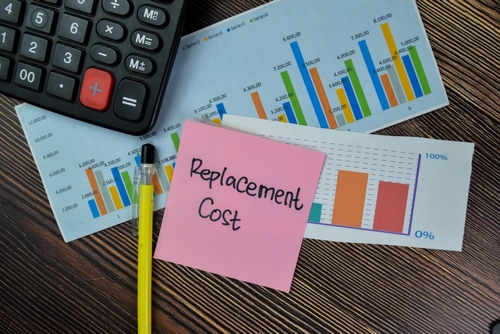UNDERSTANDING REPLACEMENT COST VS. REPRODUCTION COST
Replacement Cost:
Replacement cost is a financial concept used in various fields, such as insurance, accounting, and real estate, to determine the cost of replacing an asset with an equivalent or similar one at current market prices. This value represents the expense incurred to obtain a new asset of the same quality and functionality as the one being replaced, assuming it is lost, damaged, or no longer usable.
In the context of insurance, replacement cost is often used to determine the coverage amount needed for an insured item. It ensures that policyholders receive sufficient compensation to replace a damaged or lost asset without considering depreciation.
Key points about replacement cost:
- Current Market Prices: Replacement cost considers the current prices of assets or materials, not their historical or depreciated values.
- No Depreciation: It does not take into account the wear and tear or depreciation of the existing asset.
- Quality Match: The replacement asset should be of similar quality, function, and utility as the original.
- Insurance: It is commonly used in insurance policies to ensure policyholders can fully recover their losses.
Reproduction Cost:
Reproduction cost is a financial concept used primarily in the field of real estate appraisal. It refers to the cost of duplicating or reproducing a building or structure exactly as it exists at a specific point in time. This includes all aspects of the structure, such as materials, design, and workmanship, to create an identical replica.
In real estate valuation, reproduction cost is often used when appraisers need to assess the value of a property for insurance purposes, historical preservation, or in cases where the property is unique and cannot be easily replaced with a standard building.
Key points about reproduction cost:
- Exact Replica: Reproduction cost aims to replicate a structure exactly as it is, including its architectural details and unique features.
- Materials and Labor: It considers the cost of using the same materials and labor as the original construction.
- Historical and Unique Properties: It is particularly useful for valuing historical or architecturally significant properties where the replacement with a standard structure is not feasible.
- Insurance and Preservation: Reproduction cost is often used in insurance policies for unique or historical properties and in preservation efforts to maintain the original character of a building.
Replacement cost focuses on obtaining a similar asset at current market prices, while reproduction cost is concerned with recreating an identical replica of a structure, often used in real estate appraisal for unique or historically significant properties. Both concepts are important in various financial and insurance contexts to ensure proper valuation and coverage.
When it comes to valuing assets or properties, two essential concepts often come into play: Replacement Cost and Reproduction Cost. Both are crucial for determining the worth of an item, but they serve different purposes and are calculated differently. In this article, we’ll break down the key differences between these two valuation methods.
| Aspect | Replacement Cost | Reproduction Cost |
|---|---|---|
| Definition | The cost to replace an asset with a similar one, assuming it is not new but has the same utility and functionality. | The cost to recreate an exact duplicate of the asset, taking into account current prices and techniques. |
| Purpose | Used in insurance claims and accounting for damaged or lost assets. | Typically employed in historical preservation or when recreating rare or unique assets. |
| Assumptions | Assumes the asset is not new and may factor in depreciation. | Assumes the asset is new and requires identical materials and methods. |
| Scope | May allow for using modern, cost-effective materials and techniques. | Demands the use of original, often more expensive, materials and methods. |
| Flexibility | Offers flexibility in choosing materials and methods that fit the budget and purpose. | Requires strict adherence to historical or exact specifications. |
| Cost Changes Over Time | Replacement costs can change with market fluctuations and technology advancements. | Reproduction costs tend to remain relatively stable, as they are based on historical data. |
| Examples | Replacing a damaged car with a similar make and model but not necessarily brand new. | Recreating an antique piece of furniture using the same materials and techniques from its era. |
| Practical Use | Widely used in everyday scenarios for assessing property value and insurance claims. | Less common and often reserved for specialized fields like historical restoration. |
Key Takeaways
- Purpose: Replacement cost is primarily used for practical purposes like insurance claims and property valuation, whereas reproduction cost is typically reserved for historical preservation and replicating unique items.
- Assumptions: Replacement cost considers depreciation and allows for the use of modern materials, while reproduction cost assumes newness and requires original materials and methods.
- Scope: Replacement cost offers flexibility in materials and techniques, while reproduction cost demands strict adherence to historical or exact specifications.
- Cost Changes Over Time: Replacement costs can fluctuate with market changes and technological advancements, while reproduction costs tend to remain stable.
- Practical Use: Replacement cost is widely applicable in everyday scenarios, while reproduction cost is less common and specific to specialized fields.
Understanding the difference between replacement cost and reproduction cost is essential for making accurate valuations, whether you’re dealing with insurance claims, property assessments, or historical preservation projects. Each method has its unique purpose and assumptions, making them valuable tools in various contexts.


